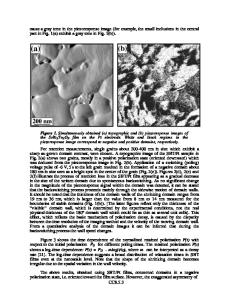Ferroelectric and Fatigue Properties of Alkoxy-Derived CaBi 2 Ta 2 O 9 Thin Films
- PDF / 397,165 Bytes
- 6 Pages / 595 x 842 pts (A4) Page_size
- 100 Downloads / 342 Views
Ferroelectric and Fatigue Properties of Alkoxy-Derived CaBi2Ta2O9 Thin Films Kazumi Kato1, 2, Kazuyuki Suzuki1, Kaori Nishizawa1, Takeshi Miki1 1 National Industrial Research Institute of Nagoya, 1 Hirate-cho, Kita-ku, Nagoya 462-8510, Japan, [email protected] 2 Frontier Collaborative Research Center, Tokyo Institute of Technology, 4259 Nagatsuda-cho, Midori-ku, Yokohama 226-8503, Japan ABSTRACT CaBi2Ta2O9 (CBT) thin films were successfully prepared on Pt-passivated quartz glass substrates using a triple-alkoxide solution. The thin film crystallized to a single phase of perovskite at 750ºC via a mixture of fluorite and perovskite phases. The 750ºC-annealed thin film showed random orientation and consisted of fine grains with a diameter of about 80 nm. The dielectric constant and loss factor were 124 and 0.04, respectively, and were constant in the frequency range of 10 kHz to 1 MHz. The thin film exhibited P-E hysteresis loops at relatively high voltages. The remanent polarization and coercive electric field were 6.9 µC/cm2 and 170 kV/cm at 13 V, respectivey. The fatigue behaviors against various electric pulse sequences were examined. The polarization did not change when the pulse width was short such as 10-6 s, however, it increased gradually with number of switching cycles when the pulse width was relatively long such as 10-3 s. INTRODUCTION CBT is a member of Bi-based layer-structured perovskite compounds such as SrBi2Ta2O9 (SBT) and SrBi2(Ta, Nb)2O9 (SBTN) [1], for which there has been much research on their potential for nonvolatile random access memory application [2]. Compared with SBT and SBNT ceramics, the dielectric constants were reported to be low for CBT ceramics [3]. Therefore, the CBT thin film is considered to be a good candidate for application to nonvolatile ferroelectric memory with the metal-ferroelectric(-metal)-insulator field effect transistor (MF(M)ISFET) structure. For such memory, the ferroelectric thin film needs to have not a high remanent polarization but only sufficient polarization to modulate the FET channel conductivity. It is important for the ferroelectric thin film to have a low dielectric constant in order to reduce charge injection from the semiconductor. In our previous works, CBT thin films were successfully synthesized by using a triple alkoxide solution [4-6]. The triple alkoxide was found to be a key material not only for the synthesis of SBT and SrBi2Nb2O9 (SBN) ferroelectric thin films [7-13] but also for the synthesis of CBT thin films. It was because the arrangement of metals and oxygen in the triple alkoxide molecules was identical to sublattices of SBT, SBN and CBT perovskite crystals. As a result, the activation energy for crystallization was lowered. In the present study, characteristics of the microstructure and surface morphology of the alkoxy-derived CBT thin films on Pt-passivated glass substrates under and over the ferroelectric phase transition were investigated. The dielectric and ferroelectric properties were addressed. Additionally, dependence of fatigue
Data Loading...











